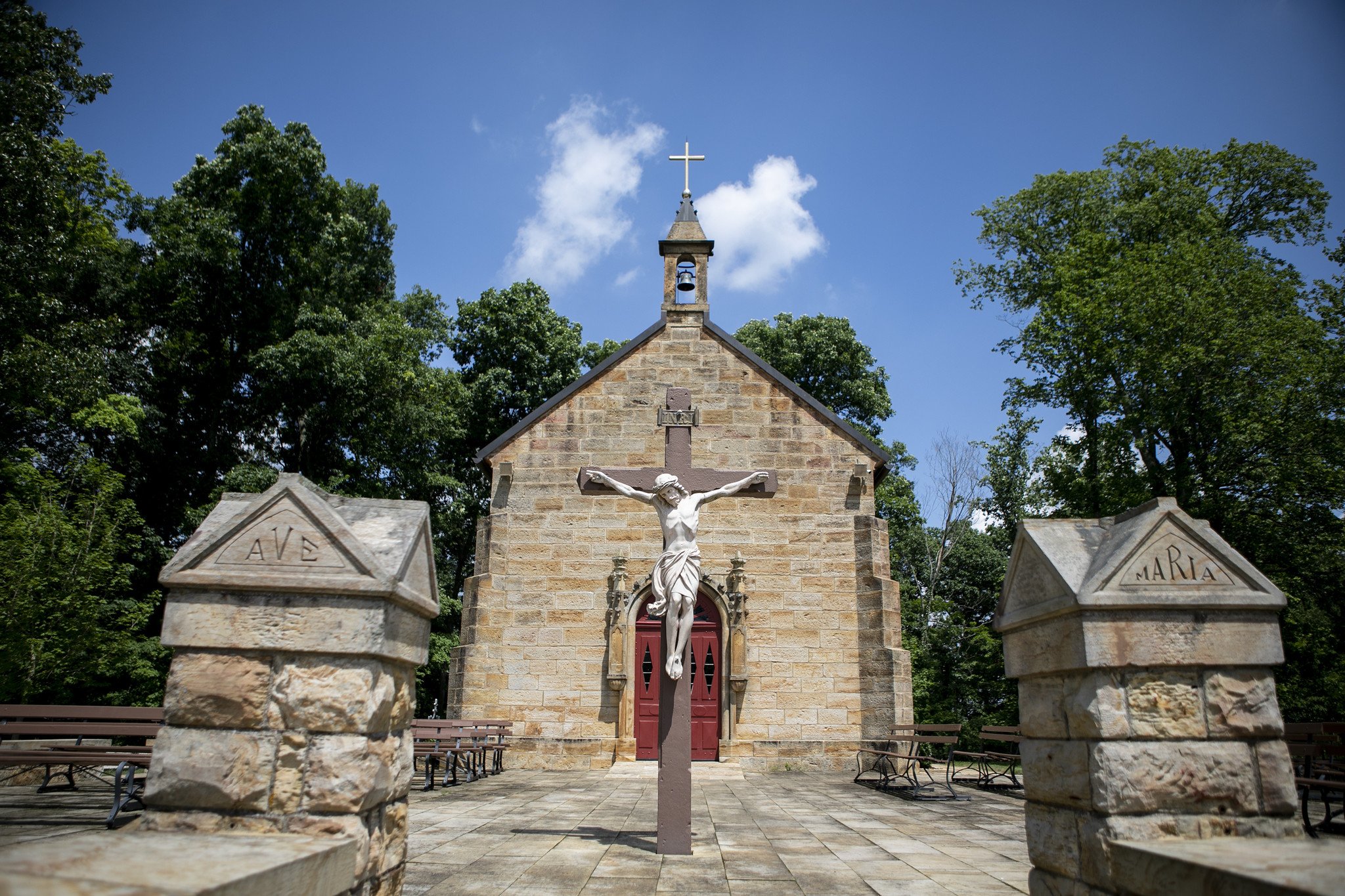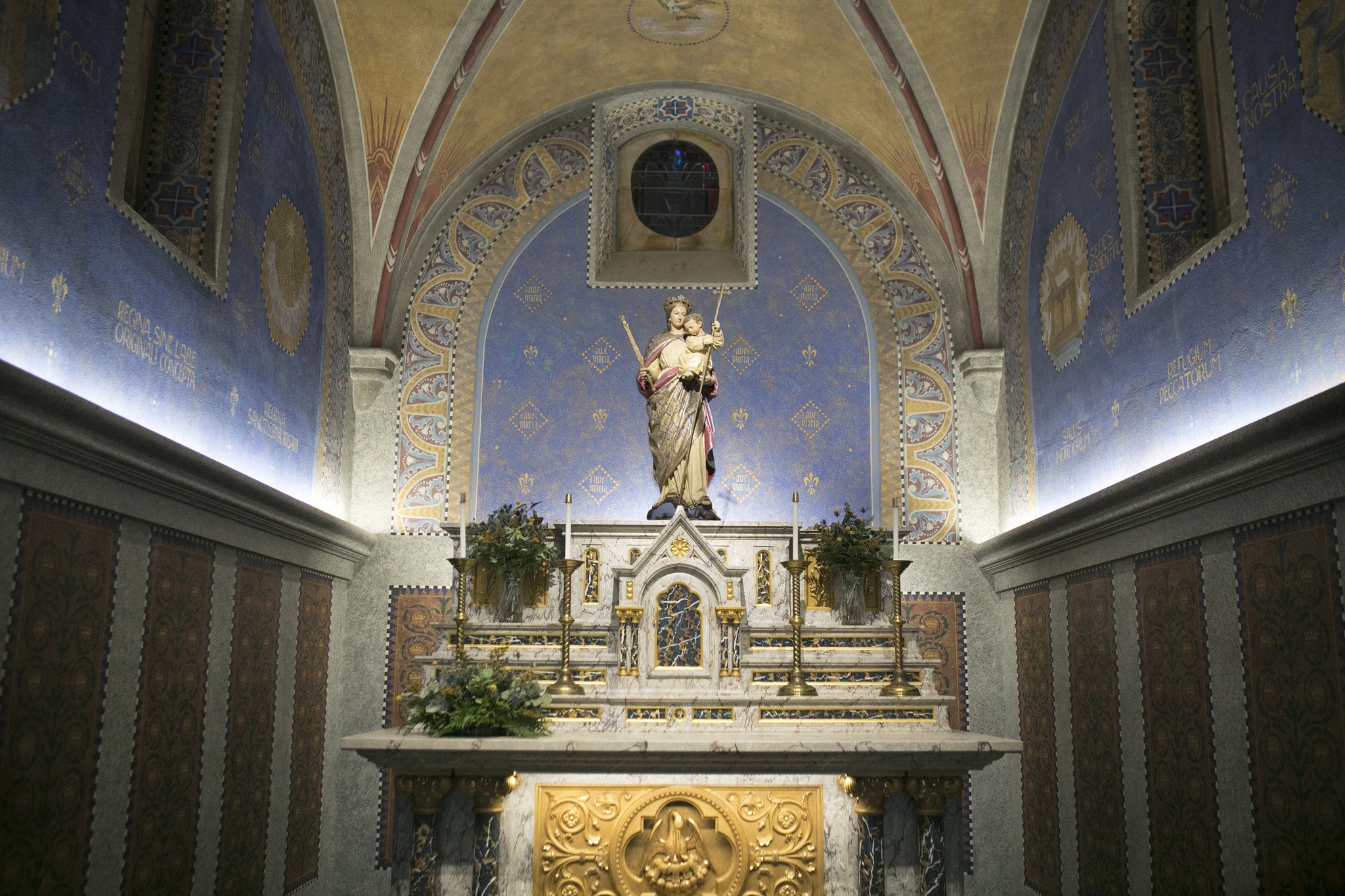Monte Cassino Shrine
- Posted on
- Posted in Monte Cassino, Shrine

The small chapel of Monte Cassino is located on a hill near the Archabbey. Surrounded by trees and panoramic views of the Anderson Valley, the shrine dedicated to the Blessed Virgin Mary is a testament to the age-old tradition of seeking God.
Learn about the history of Monte Cassino Shrine, its restoration and the pilgrimages that are still held today.
Shortly after Saint Meinrad Archabbey was founded by two Benedictine monks from Switzerland, the new foundation began its work of preparing men for the priesthood.
In those early days, monks and students discovered a favorite spot for hikes, picnics and games on a nearby wooded hill. Fr. Chrysostom Foffa, OSB, named the site Monte Cassino, after the great abbey in Italy where St. Benedict lived in the sixth century.
In the autumn of 1857, a monk and some seminary students attached an image of the Immaculate Conception to an oak tree near the entrance to the grove. In the style of a wayside shrine, they carved a niche in the oak tree and protected the lithograph print of Mary with a crude wooden roof.
Devotion to Our Lady Spreads
During the mid-19th century, devotion to Mary at the little shrine grew. Travelers, farmers, immigrants and soldiers climbed Monte Cassino Hill to ask for Our Lady's intercession and help.
By 1866, the seminary's first rector, Fr. Isidor Hobi, OSB, decided that a more worthy expression of the growing devotion was needed. He and the seminarians built a 12'x14' frame building about 150 feet west of the present structure. They installed the simple image of the Immaculate Conception in this new chapel.
A year later, sandstone of excellent quality was discovered on Monte Cassino Hill. When the sandstone was excavated for use in erecting the monastery and school buildings, Saint Meinrad's superior ordered the first stones to be set aside for a permanent chapel at Monte Cassino.
Shrine Dedicated in 1870
The chapel's design was based on a picture of the early shrine of Our Lady at Einsiedeln, the motherhouse of Saint Meinrad Archabbey. Although only the sanctuary section was finished, the new chapel was dedicated on May 1, 1870. The rest was completed in 1873.
During the dedication, a wooden statue of the Blessed Virgin and Child, hand carved in Switzerland, was blessed and installed above the altar, where it remains today.
About 2,000 attended the celebration. The event was marked with a festive procession, singing, cannon blasts, and prayer by the monks, students and Catholics who attended from neighboring communities.
The dedication of the new chapel nurtured local piety. When an epidemic of smallpox threatened the area in the winter of 1871, the community was quick to turn to Our Lady of Monte Cassino.
Smallpox Scare
The first cases of smallpox broke out before Christmas. Several in the village had died and, during the holidays, four persons became infected at Saint Meinrad. As more cases of the disease were discovered, the worst was feared.
On January 5, all the students who could walk went on a pilgrimage to Monte Cassino, where a solemn votive Mass was offered. The pilgrimage was repeated on the last day of the novena (January 13). Since the novena was begun, not a single case of smallpox broke out. In thanksgiving, Saint Meinrad students make a pilgrimage to Monte Cassino each year around January 13.
Through the years, other reports of cures have been attributed to Our Lady's intercession. But it is not healings and claims of cures that make Monte Cassino a holy place. Rather, it is the faith and devotion of the visitors and pilgrims who come to pray or reflect, seeking to become closer to God.
Since the chapel's dedication in 1870, thousands of people have visited the sandstone chapel to offer their prayers and petitions.
Restoration of the Chapel
Weather and time took a toll on Monte Cassino Shrine. However, a generous benefactor led the effort to stabilize the aging sandstone structure, beautify the grounds, and make needed repairs and improvements.
The project was conducted in several phases during 2016 and 2017. Work to reinforce and stabilize the building and tuck point the exterior was completed in 2016.

Because the chapel was not air conditioned or ventilated, a heating, ventilation and air conditioning system was installed. This will keep the painted walls, woodwork and artwork from deteriorating. Better lighting also was added.
Among the other improvements were: new landscaping, a pathway leading to a new prayer garden, and a sandstone piazza with benches. A new addition to Monte Cassino Shrine is the outdoor prayer garden and a statue of Mary holding the Infant Jesus.
On October 1, 2017 the public was invited to attend the blessing of the newly restored Monte Cassino Shrine.
You can view a video about the project here.
Open Daily From Dawn to Dusk
Public rosary pilgrimages are held at the shrine each Sunday during May and October. In addition, a Benedictine monk of Saint Meinrad Archabbey presides at Mass in the chapel each Saturday.
During normal times, Saturday Mass times (Central Time) are:
• 7 a.m. May through October
• 8 a.m. November through April
To visit the shrine, follow Indiana 62 east from Saint Meinrad Archabbey (located in St. Meinrad, IN) for about a mile. Look for the sign that marks the entrance to the shrine.

